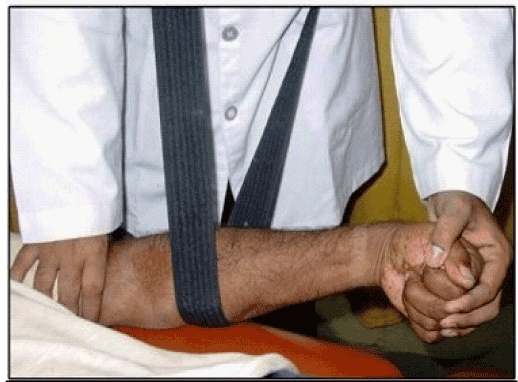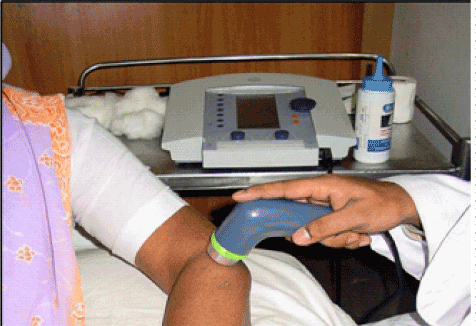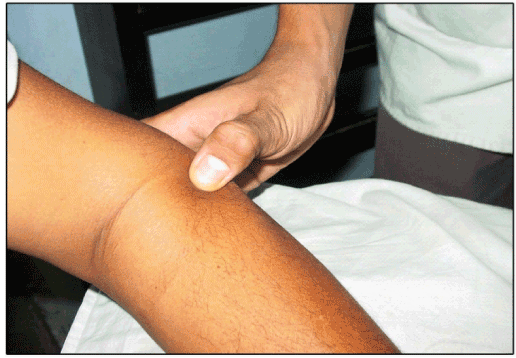Make the best use of Scientific Research and information from our 700+ peer reviewed, Open Access Journals that operates with the help of 50,000+ Editorial Board Members and esteemed reviewers and 1000+ Scientific associations in Medical, Clinical, Pharmaceutical, Engineering, Technology and Management Fields.
Meet Inspiring Speakers and Experts at our 3000+ Global Conferenceseries Events with over 600+ Conferences, 1200+ Symposiums and 1200+ Workshops on Medical, Pharma, Engineering, Science, Technology and Business
Research Article Open Access
Mobilization with Movement Technique as an Adjunct to Conventional Physiotherapy in Treatment of Chronic Lateral Epicondylits-A Comparative Study
| Deepak B Anap*, Mahendra L Shende and Subhash Khatri | |
| College of Physiotherapy, PIMS, Loni-413736, Maharashtra, India | |
| Corresponding Author : | Dr. Deepak B Anap College of Physiotherapy, PIMS Loni-413736, Maharashtra, India E-mail: deepak.anap@hotmail.com |
| Received July 20, 2012; Accepted August 27, 2012; Published August 30, 2012 | |
| Citation: Anap DB, Shende ML, Khatri S (2012) Mobilization with Movement Technique as an Adjunct to Conventional Physiotherapy in Treatment of Chronic Lateral Epicondylits-A Comparative Study. J Nov Physiother 2:121. doi: 10.4172/2165-7025.1000121 | |
| Copyright: © 2012 Anap DB, et al. This is an open-access article distributed under the terms of the Creative Commons Attribution License, which permits unrestricted use, distribution, and reproduction in any medium, provided the original author and source are credited. | |
Visit for more related articles at Journal of Novel Physiotherapies
Abstract
Lateral epicondylitis or tennis elbow is the major challenge, as it is difficult to treat, prone to recurrence and may last for several weeks or months. The present study was conducted on 40 subjects to find out the effectiveness of Mulligan’s Mobilization with Movement (MWM) technique and conventional physiotherapy in the treatment of Chronic Lateral Epicondylitis. We found that MWM technique is more beneficial than conventional physiotherapy alone in eliminating pain of previously painful active movements and the overall improvement in the condition.
| Keywords |
| Lateral epicondylitis; Mobilization With Movement (MWM) |
| Introduction |
| Lateral epicondylitis or tennis elbow is one of the most common lesions of the arm. This injury is a major challenge, as it is difficult to treat, prone to recurrence and may last for several weeks or months, with an average duration of a typical episode which has been reported to be between six months to two years [1]. The dominant arm is more commonly affected and the incidence of tennis elbow in practice is approximately 4 to 7 per 1000 patients per year with the annual incidence of 1-3% in the general population which increases to 19% in 30-60 years old population specifically and appears to be more long standing and severe in women [1,2]. |
| A common presentation may consist of pain and tenderness over the lateral epicondyle of the humerus, the radial head, the fascia between and the origins of extensor muscles as well as radiating occasionally into the forearm. Many people complain of weak and painful grasp [3,4], eventually shaking hands along with which turning a door handle, picking up a milk carton or carrying a briefcase may cause severe pain around the epicondyle. The traditional view is that tennis elbow is initiated by macroscopic or microscopic tears at the common tendon of the wrist extensor muscles due to chronic overuse. |
| As these tears attempt to unite, the healing surfaces are pulled apart with continued use of hand, resulting in self perpetuating and chronic inflammation. This theory was initially put forward by Dr. J Cyriax in 1936 and has since been widely accepted as the most plausible pathophysiological mechanism [5]. This inflammatory model also led to the use of the term “Epicondylitis” which was considered as an improvement over colloquial term “Tennis Elbow”. |
| Yet this theory has never been substantiated and indeed has been refuted as early as the 1970s by Dr. R Nirschl, based on the histopathological examination of over 600 cases of chronic lateral epicondylalgia [6]. His studies consistently demonstrated that the affected tendon (usually the Extensor Carpi Radialis Brevis [ECRB] tendon) was characterized by a dense population of fibroblasts disorganized and immature collagen and an absence of inflammatory cells. These findings are considered characteristic of a degenerative process which he called “Angiofibroblastic Hyperplasia”, now commonly known as tendinosis [7,8]. |
| Numerous manual therapy procedures have been developed to assist in the management of lateral epicondylitis namely by Mills, Cyriax, Kalternborn, Menell, Stoddard, Hartman and Maitland. All of them have described various permutations of varus/extension direction manipulation applied to the lateral elbow. There is little appreciable research by Indian researchers, comparing two protocols in cases of Chronic Lateral Epicondylitis. |
| Hence, we have designed two treatment protocols to study their independent effects in treating Chronic Lateral Epicondylitis. The purpose of the present study was to examine effectiveness of Mobilization with Movement (MWM) along with conventional therapy in treating Chronic Lateral Epicondylitis. |
| Method |
| Subjects were 15 males and 25 females, from ages 30 to 55 years old (mean, 39.45 years). Their heights varied from 156 cm to 162 cm (mean, 158.5 cm) and weighed between 66.7 kg to 81.6 kg (mean, 76.3 kg). Patients who were included in the study were the ones with pain on lateral side of the elbow since the last 3 months which would be aggravated when pressure was applied on lateral humeral epicondyle and resisted wrist extension. Patients with severe neck or shoulder problems, persons on steroids/analgesics for the present complaints, prior surgeries of elbow, dislocations of joints, tendon ruptures or fracture in the area over prior year were excluded. The study was explained to all volunteers and each subject signed an informed consent. Ethical clearance for the study was obtained from the Ethical Committee, Pravara Institute of Medical Sciences, Loni. |
| Procedure |
| Subjects were randomly assigned into one of the two groups A and B and which were assigned one the two study protocols without them being disclosed to the members of that group. Group A received the manual therapy protocol which included Mobilization with Movement (MWM) along with ultrasound, deep friction massage, stretching and strengthening for wrist extensors and wrist flexors for four sessions in a week for three weeks while Group B received conventional therapy protocol treatment which included therapeutic ultrasound, transverse friction massage and stretching and strengthening exercises. |
| For the group A Mulligans mobilization with movement involved the application of lateral glide to the elbow joint which was sustained while an exercise, activity or movement was performed [9]. Mobilization belt was placed around the patient’s proximal forearm and across the therapist’s shoulder while the distal humerus was stabilized with one hand. Lateral glide was applied to the forearm through belt and sustained for about 5-10 sec. While the patient performed repeated wrist extension against manual resistance applied by the therapist’s hand. The lateral glide was released after the subject had achieved the pain free wrist extension. Six repetitions were performed with a 15 sec. rest interval between repetitions [9] (Figure 1). |
| This was followed by pulsed ultrasound for 71/2 mins around lateral humeral epicondyle (Sonopuls). At a frequency of 1Mhz and a 20% duty cycle was given with an intensity of 2 w/cm2 (Figure 2). |
| Deep friction massage was applied for 10 mins on the antero-lateral aspect of the lateral epicondyle was located at the facet of the lateral epicondyle, where the Extensor Carpi Radialis Brevis [ECRB] inserts, which is also the most common site of pain in patients with tennis elbow (Figure 3). |
| When pain subsided, patients were instructed on strengthening and stretching of wrist extensors and flexors. Only when a patient was able to perform an exercise step, he or she was allowed to perform next step. Each exercise included 10 repetitions in a series of 2-3 steps. The exercise programs were performed 4 to 6 times daily at home. From group B conventional therapy protocol treatment which included therapeutic ultrasound, transverse friction massage and stretching and strengthening exercises was followed where the stretching and strengthening of wrist flexors and extensors was given as per the protocol described by Pienimaki et al. [10]. |
| Dependent variables like Visual Analogue Scale (VAS), Pain Free Grip Strength (PFGS) and Global measurement of Improvement Scale (Is) were recorded before and after the interventions for the patients in both the groups. |
| Data analysis |
| The level of significance for visual analogue scale, pain free grip strength and global measure of improvement was calculated by applying an un-paired sample t-test. |
| Results |
| After the application of the un-paired t-test the outcome exhibited a highly significant (p< 0.01) reduction in the pain and improvement in pain free grip strength in manual therapy group (Gr. A) as compared to the conventional physiotherapy group (Gr. B). And there was a significant (p<0.05) reduction in score of global measure of improvement in manual therapy group (Gr. A) as compared to the conventional physiotherapy group (Gr. B) (Table 1). |
| Discussion |
| Our study showed that manual Therapy Group (Group A) and Conventional Physiotherapy Group (Group B) both were effective for pain relief and dysfunction associated with Chronic Lateral Epicondylalgia. But improvement with Manual Therapy Group which was based on Mulligans principle was greater as compared to Conventional Physiotherapy Group. This study confirmed that the MWM technique is capable of producing hypoalgesic effect by the end of the 3rd week. There was significant improvement (t=2.82, p<0.01) in the manual therapy group as compared to conventional physiotherapy group. |
| The neural system responsible for manipulative therapy induced pain modulation is likely complex. Previous studies have suggested that manipulative therapy might provide an adequate non-noxious sensory input to activate Descending Pain Inhibitory System (DPIS) as a major component of its pain relieving effects [11,12]. |
| The MWM treatment technique produced significant improvement (t=5.45, p<0.01) in the Pain free Grip Strength at the end of 3rd week as compared to the conventional therapy group. The effect profile is contrast to that of lateral glide technique of the cervical spine, a spinal manipulative technique for Lateral Epicondylalgia that has been previously investigated. The lateral glide of cervical spine produced an improvement of the order of 12-30% and an improvement in pressure pain threshold of approximately 25-30% immediately following treatment [9,12]. |
| The improvement in grip strength was co-related with improvement in functional parameters of the upper extremity. Our study showed significant improvement (t=2.25, p<0.05) in Global Measure of Improvement Scale (IS) in manual therapy group at the end of 3rd week as compared to the conventional therapy group. This is accompanied with decrease in Visual Analogue Scale (VAS) pain at rest, pain during the day and inconvenience. |
| MWM technique are proposed to restore normal tracking of the radius on the capitulum so that strengthening of forearm muscles can be done without painful symptoms which leads to Pain Free Grip Strength (PFGS) [13]. Local effects such as possible changes in the relationship of bones and soft tissues about the joint and possible changes in local neural receptors in soft tissues at the time of treatment may account for the changes we measured [14]. |
| The parameters of therapeutic ultrasound in this study reporting enhanced recovery coincides with the findings of the earliest study by Strujjis et al., were 1 Mhz, 7.5 mins, 20% Duty Cycle, Intensity 2W/cm2 [4]. Ultrasound is thought to enhance blood flow, increase membrane permeability, alter connective tissue extensibility and nerve conduction [8,10]. |
| Progressive stretching and strengthening exercises for wrist flexors and extensors were identified as popular treatments for Chronic Lateral Epicondylitis patients in terms of pain levels [10], maximum grip strength, sleep disturbance, subjective ability to work and isokinetic torque of wrist flexion and extension. Limitation of our study was that only short term effects were investigated but to be fair patients are often mainly interested in a fast recovery, effects over the long term may be less distinctive due to, factors like recurrence of symptoms. |
| Conclusion |
| In our study there was significant difference between manual therapy protocol and conventional therapy protocol in treating Chronic Lateral Epicondylitis. Manual therapy protocol was more beneficial than the conventional therapy protocol in eliminating pain of a previously painful active movement and the overall improvement in the condition. |
| Investigation of long term effect of MWM technique for Chronic Lateral Epicondylitis in Indian population with large number of sample and longer session is important. Further research is required to find out effect of MWM in structural faults related with Chronic Lateral Epicondylitis and mechanism of pain relief. |
References
- Stasniopoulos D, Johnson MI (2005) Effectiveness of Extracorporeal Shock Wave therapy for Tennis elbow. Br J of Sports Med 39: 132-136.
- Allander E (1974) Prevalence, Incidence and Remission rates of some common rheumatic diseases or symptoms. Scand J Rheumatol 3: 143-153.
- Anthony E Foley (2003) Tennis Elbow. American Family Physician.
- Struijs PA, Damen PJ, Bakker EW, Blankevoort L, Assendelft WJ,et al. (2003) Manipulation of the wrist for management of lateral epicondylitis: a randomized pilot study. Phys Ther 83: 608-616.
- Cyriax Diagnosis of Soft tissue lesion 269-272.
- Kraushaar BS, Nirschl RP (1999) Tendinosis of the Elbow (Tennis Elbow). Clinical Features and findings of histological , Immuniohistochemical and electron Microscopy studies. J Bone Joint Surg Am 81: 259-278.
- Esther J Waugh (2005) Lateral Epicondyalagia or Epicondylitis: What is in a name? J Orthop Sports Phys Ther 35: 200-202.
- Stansinopoulos D, Stansinopoulou K, Johnson MI (2005) An exercise programme for the management of lateral elbow tendinopathy. British J of Sports Med 39: 944-947.
- Vicenzino B (1995) Effect of Novel manipulative physiotherapy technique on tennis elbow: a single case study. Man Ther 1: 30-35.
- Pienimaki TT, Tarvainen TK, Siira PT, Vanharatna H (1996) Progressive Strengthening and stretching exercise and ultrasound for chronic lateral epicondylitis. Physioth 82: 522-530.
- Vicenzino B, Collin D, Wright A (1996) The initial effect of a Cervical spine manipulative physiotherapy treatment on the pain and dysfunction of Lateral Epicondylalgia. Pain 68: 69-74.
- Vicenzino B, Collin D, Benson H,Wright A (1998) An investigation of the interrelationship between manipulative therapy induced Hypoalgesia and Sympathoexcitation. J Manipulative Physiol Ther 21: 448-453.
- Hsieh C, Vicenzino B, Yang Ch, Hu MH, Yang C (2002) Mulligan├ó┬?┬?s Mobilisation with movement for the thumb: A single case study report using magnetic resonance imaging to evaluate the positional fault hypothesis. Man Ther 7: 44-49.
- Kavanagh J (1999) Is there a positional fault at the inferior tibiofibular joints in patients with acute or chronic ankle sprains compared to normals? Man Ther 4: 19-24.
Tables and Figures at a glance
| Table 1 |
Figures at a glance
 |
 |
 |
| Figure 1 | Figure 2 | Figure 3 |
Post your comment
Relevant Topics
- Electrical stimulation
- High Intensity Exercise
- Muscle Movements
- Musculoskeletal Physical Therapy
- Musculoskeletal Physiotherapy
- Neurophysiotherapy
- Neuroplasticity
- Neuropsychiatric drugs
- Physical Activity
- Physical Fitness
- Physical Medicine
- Physical Therapy
- Precision Rehabilitation
- Scapular Mobilization
- Sleep Disorders
- Sports and Physical Activity
- Sports Physical Therapy
Recommended Journals
Article Tools
Article Usage
- Total views: 9973
- [From(publication date):
November-2012 - Aug 24, 2025] - Breakdown by view type
- HTML page views : 5138
- PDF downloads : 4835
